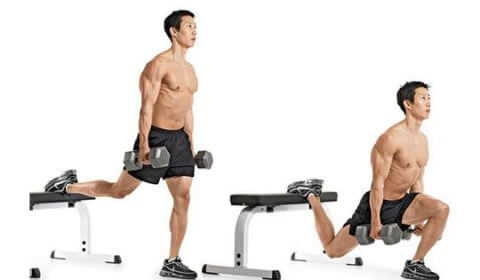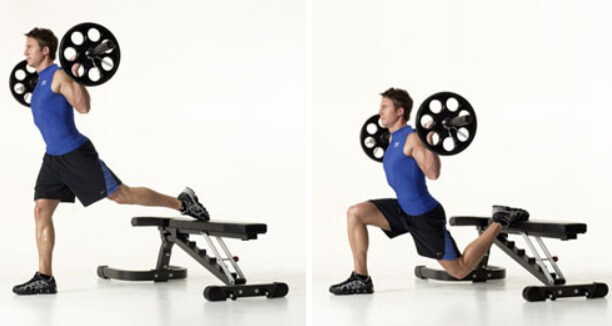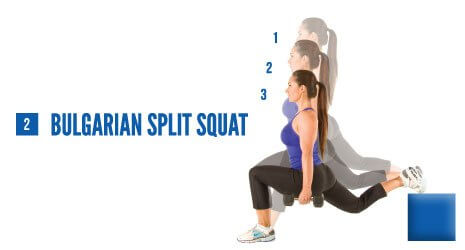
You’ve heard it a million times before: you can’t skip leg day. Yes, we all love giant biceps and full chests, but if you’re not focusing on your booty and the rest of your lower body you’re missing out.
But what kind of exercises can you even do for leg day?
The standard squat and leg curls grow tiresome quickly.
Variety is the spice of life, and leg day could really use some. That’s why you need to add in the Bulgarian split squat into your workout. If you’ve never done the move before, it’s about to completely change the way you go about workout your lower body.
So don’t worry if you’re not familiar with the move.
We’ve got everything you need to know right here.
What is a Bulgarian Split Squat?
This is a move you may have seen around the gym, but you just didn’t know the actual name of it.
There are tons of ways to isolate your lower body like jump squats, Romanian deadlifts, goblet squats, front squats and so on but what makes the Bulgarian split squat special?
The Bulgarian split squat is the combination of a lunge and a squat yet with more isolation.
As you would with a traditional squat, you’ll have a loaded barbell over your shoulder with each hand holding onto the bar, stabilizing it on your shoulder and back. You then take one leg and extend it behind you, placing it on a bench.
This elevates your leg and will help isolate the muscles. From here, you lower yourself straight down, maintaining a straight back. While maintaining your balance, you’ll feel the stretch and tension right in your gluteus.
After reaching the bottom of the split squat you’ll push yourself back up to the starting position. This is one rep for one side.
History of the Bulgarian Split Squat
The traditional squat is one of the oldest lower body lifts.
As it bases itself off of the idea of picking up something off the ground and raising your body back to a stand, this move, in some form, has been performed for centuries.
However, the Bulgarian split squat variation is one of the newer additions to the squat family.
The actual creator of the Bulgarian split squat is not known.
However, based on journal entries and documentation, it is believed the Bulgarian split squat originated as an Olympic lift exercise during the Cold War. During the early days of Olympic Weightlifting, lifts including the Clean and Jerk used a split motion with one leg extended out behind the lifter and one bent at a 90-ish degree angle in front of the lifter (nearly identical to what the Bulgarian split squat looks like).
The Cold War proved to be a very demanding time not only for politics but for anyone going into direct competition with a member of the opposing side.
Due to this, the Soviet Union and many of the Soviet satellite nations looked for ways to improve strength in order to best Americans and western European countries in open competition. During the 1970s and 1980s, Bulgaria turned itself into one of the leading weightlifting nations in the world.
It is at this time the Bulgarian split squat seemed to make its first widely used appearance in training throughout Bulgaria as lifters looked towards ways to improve their front loaded squats (and avoid heavy back based squatting in order to avoid complications in the back).
Eventually, a Canadian weightlifter discovered the lift while updating a German weightlifting instructional manual. He taught the lift to several of his training friends, including one man who eventually went on to become the strength coach at the United States Air Force Academy.
This helped introduce the Bulgarian split squat to lifters in the U.S. Since then, the use of the squat variant has become an especially popular lift throughout the rest of the world due to its ability to target the largest muscle groups in the lower body while working nearly every muscle below the hips (Physical Culture Study, 2017).

Equipment Needed
The traditional Bulgarian split squat is performed with a loaded barbell and a bench to place your foot on.
However, it is possible to perform the lift with dumbbells as well. When using dumbbells you have two options. The first option is to hold each dumbbell above your shoulders, similar to your starting position for an overhead press. This closely mimics the weighted alignment of a barbell Bulgarian split squat. The option is to have your arms hold the dumbbells by your side as you squat.
There are pros and cons to each of these moves.
The pro with holding the dumbbells by your side is you work your arms during the workout. However, the perk with holding the weights by your shoulders is you have more weight placed directly above your spine and your butt, which places more weight on the target muscle. As you are performing the Bulgarian split squat to strengthen your lower body, the ideal option is to have the weight near your shoulders when using dumbbells, but it is up to you (Men’s Fitness, 2017).
Outside of a barbell and dumbbells, you can also use kettlebells.
These weights may be easier to hold.
Much like selecting the kind of holding position for dumbbells or if you use a barbell instead, this comes down to personal comfort and what you like better.
As you increase your weight though you’ll likely have to move to dumbbells or a loaded barbell as you may not find kettlebells with enough weight.

Bulgarian Split Squat Variations
Realistically, each of the weight and position options works your lower body in the same way.
It is all about the squatting movement and holding your knee just above the floor for a second before raising up. However, there are some conditions where you might want to select one over the other.
The Bulgarian split squat, unlike most other squats, does not place a barbell on the back or the chest.
This is desirable if you’ve suffered from any kind of back issues. Whether you have a sore back, had back surgery in the past or there is another problem altogether, using your spine to support heavy weight places additional strain on your injury you need to avoid. If this is a situation you are in you need to hold the weight at your side.
This, in fact, is what makes the Bulgarian split squat such a desirable lift. For people who suffer from back problems, many are not able to perform lifts like the front or back squat, each of which are key components in a lower body workout.
As the Bulgarian split squat can remove the weight from the back, you can still effectively work the lower body without the need to include your spine.
I Do the Split Squat. Is There a Point to the Bulgarian Split Squat?
Outside of changing the move up a little bit and throwing on a different name, if you already do the split squat, should you move to the Bulgarian split squat?
The beauty of both the split squat and the Bulgarian split squat is you focus on one leg at a time instead of the traditional squat, which does both. The advantage here is you force each leg to perform on its own, instead of relying on the other side.
Now, both of the split squats work for the same muscle groups as you perform the same basic movement.
However, as the Bulgarian split squat requires one leg to be elevated, it increases the tension placed on the leg. As you lower yourself down, there is an additional stretch running down from the gluteus caused by the elevated leg.
By increasing the tension in this area of the body you’ll see improved results and better size gains than with a regular split squat.
You may not see necessarily a drastic increase in strength, so if this is what you’re going for it may not provide the effective boost over a standard split squat. However, if you want a larger butt and wider hamstrings, you should make the move from split squat to Bulgarian split squat.
You are free to perform both lifts during your workout. However, as both moves are nearly identical outside of the elevated leg, there isn’t a need unless you’re attempting to completely burn out your legs to failure.
In that case, use both moves. If you only have enough time for one move though you should start with the Bulgarian split squat.

Muscles Worked By the Bulgarian Split Squat
The Bulgarian split squat targets your lower body, but what specific muscle groups do you hit?
After all, if you’re someone who spits up your lower body into individual days, you need to know this. When performing the lift, you’ll specifically hit the gluteus maximus and the quadriceps. You’ll also hit both the soleus and magnus adductors. On top of it all, you’ll utilize a host of stabilizer muscles for the move, including the gluteus medius and minimus, plus the hamstrings and gastrocnemius.
The gluteus maximus is the main shape of your buttocks and is the largest muscle within your butt area.
The other portions of the buttocks area, the gluteus medius, and minimus run along the hip bone and act as stabilizers. The other major muscle group targeted with the Bulgarian split squat is the quadriceps, which runs the front of your legs, stretching down from the hip bone to the kneecap.
The secondary muscles hit with the move include the soleus and magnus adductors.
These muscles run along the side of your thigh and also make up a portion of the hamstring while the remainder of the hamstring acts as a stabilizer muscle. So ultimately, the Bulgarian split squat hits in some shape or form nearly every muscle group in the lower body.
Tips and Workout Routine
When performing the Bulgarian split squat, it is very important to keep your back straight and your chest up.
This helps keep your hips in line with your spine and avoids any possible injuries. It also helps you maintain your balance while performing the lift.
You also need to lower yourself down at the hips and not rock yourself forward. Rocking yourself forward opens you up to knee injuries due to the increased amount of weight on the bent knee. It also reduces the strength impact placed on your butt and quads, which limits the effectiveness of the lift. Lastly, you want to make sure and keep the grounded leg straight.
It may begin to slant inward, which you need to avoid. Once it starts doing this your hips will begin to twist, which can cause problems with balance while also increase the chance of an injury with your hips and lower back.
As for your workout, load up the barbell or dumbbells so you can hit between eight and 12 reps per set. This is per leg. If you are fully exhausted before you hit eight that is fine as it will help increase strength, but it reduces your chance for size gain. Maximum size gain is obtained when you max out at nine or 10 reps per set. After you complete a set switch to the opposite leg and repeat.
You want to perform the Bulgarian split squat twice per leg when first starting out. As your legs become accustomed to the lift over the next few weeks, increase the weight and push yourself to three sets.
Due to the number of muscle groups the Bulgarian split squat hits, perform this lift towards the beginning of your lift day routine.
Conclusion
The Bulgarian split squat needs to be the main focus in your lower body workout. If you want a strong butt, the split squat targets each side individually while also strengthening stabilizing muscles as you balance the split.
So take your leg workout to the next level by adding this beauty to it.
-Terry Asher
Terry Asher
Latest posts by Terry Asher (see all)
- Better Family – Product Review Liquid Daily 2 oz - Dec 16, 2024
- Post-Workout Recovery: The Key to Optimal Performance - Nov 25, 2024
- Pre-Workout Supplements – Everything You Need To Know - Nov 18, 2024










[…] post Bulgarian Split Squat – Why You Should Add It To Your Workouts appeared first on Gym […]
Nice post, Terry!
I hate the notion that back squatting is the only way to get bigger and stronger. The Bulgarian Split Squat is a great alternative. I like to recommend it for preventing muscle imbalances, challenging mobility, stretching hip flexors, and improving balance.
[…] may see this exercise called Bulgarian split squats, rear foot elevated squats, single leg elevated lunges, or plenty of other names but just know, […]